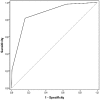The German Version of the Manchester Triage System and its quality criteria--first assessment of validity and reliability
- PMID: 24586477
- PMCID: PMC3933424
- DOI: 10.1371/journal.pone.0088995
The German Version of the Manchester Triage System and its quality criteria--first assessment of validity and reliability
Abstract
Background: The German Version of the Manchester Triage System (MTS) has found widespread use in EDs across German-speaking Europe. Studies about the quality criteria validity and reliability of the MTS currently only exist for the English-language version. Most importantly, the content of the German version differs from the English version with respect to presentation diagrams and change indicators, which have a significant impact on the category assigned. This investigation offers a preliminary assessment in terms of validity and inter-rater reliability of the German MTS.
Methods: Construct validity of assigned MTS level was assessed based on comparisons to hospitalization (general / intensive care), mortality, ED and hospital length of stay, level of prehospital care and number of invasive diagnostics. A sample of 45,469 patients was used. Inter-rater agreement between an expert and triage nurses (reliability) was calculated separately for a subset group of 167 emergency patients.
Results: For general hospital admission the area under the curve (AUC) of the receiver operating characteristic was 0.749; for admission to ICU it was 0.871. An examination of MTS-level and number of deceased patients showed that the higher the priority derived from MTS, the higher the number of deaths (p<0.0001 / χ² Test). There was a substantial difference in the 30-day survival among the 5 MTS categories (p<0.0001 / log-rank test).The AUC for the predict 30-day mortality was 0.613. Categories orange and red had the highest numbers of heart catheter and endoscopy. Category red and orange were mostly accompanied by an emergency physician, whereas categories blue and green were walk-in patients. Inter-rater agreement between expert triage nurses was almost perfect (κ = 0.954).
Conclusion: The German version of the MTS is a reliable and valid instrument for a first assessment of emergency patients in the emergency department.
Conflict of interest statement
Figures









Similar articles
-
Suitability of the German version of the Manchester Triage System to redirect emergency department patients to general practitioner care: a prospective cohort study.BMJ Open. 2019 May 6;9(5):e024896. doi: 10.1136/bmjopen-2018-024896. BMJ Open. 2019. PMID: 31064804 Free PMC article.
-
[Assessment of validity of the German version of the Manchester Triage System].Med Klin Intensivmed Notfmed. 2022 May;117(4):283-288. doi: 10.1007/s00063-021-00813-4. Epub 2021 Apr 20. Med Klin Intensivmed Notfmed. 2022. PMID: 33877424 German.
-
Reliability and validity of the Manchester Triage System in a general emergency department patient population in the Netherlands: results of a simulation study.Emerg Med J. 2008 Jul;25(7):431-4. doi: 10.1136/emj.2007.055228. Emerg Med J. 2008. PMID: 18573959
-
Modern triage in the emergency department.Dtsch Arztebl Int. 2010 Dec;107(50):892-8. doi: 10.3238/arztebl.2010.0892. Epub 2010 Dec 17. Dtsch Arztebl Int. 2010. PMID: 21246025 Free PMC article. Review.
-
Effectiveness of the Manchester Triage System on time to treatment in the emergency department: a systematic review.JBI Evid Synth. 2020 Jan;18(1):56-73. doi: 10.11124/JBISRIR-2017-003825. JBI Evid Synth. 2020. PMID: 31453842
Cited by
-
Geriatric Screening, Triage Urgency, and 30-Day Mortality in Older Emergency Department Patients.J Am Geriatr Soc. 2020 Aug;68(8):1755-1762. doi: 10.1111/jgs.16427. Epub 2020 Apr 4. J Am Geriatr Soc. 2020. PMID: 32246476 Free PMC article.
-
Suitability of the German version of the Manchester Triage System to redirect emergency department patients to general practitioner care: a prospective cohort study.BMJ Open. 2019 May 6;9(5):e024896. doi: 10.1136/bmjopen-2018-024896. BMJ Open. 2019. PMID: 31064804 Free PMC article.
-
[Concept of an interdisciplinary emergency department at the Schwarzwald-Baar Hospital].Med Klin Intensivmed Notfmed. 2014 Oct;109(7):485-94. doi: 10.1007/s00063-013-0346-8. Epub 2014 Sep 25. Med Klin Intensivmed Notfmed. 2014. PMID: 25248546 German.
-
Out of hours care in Germany - High utilization by adult patients with minor ailments?BMC Fam Pract. 2017 Mar 21;18(1):42. doi: 10.1186/s12875-017-0609-1. BMC Fam Pract. 2017. PMID: 28327082 Free PMC article.
-
"I do not know the advantages of having a general practitioner" - a qualitative study exploring the views of low-acuity emergency patients without a regular general practitioner toward primary care.BMC Health Serv Res. 2024 May 15;24(1):629. doi: 10.1186/s12913-024-10977-2. BMC Health Serv Res. 2024. PMID: 38750500 Free PMC article.
References
-
- Australasian College for Emergency Medicine policy document (2002) The Australasian triage scale. Emerg Med 14: 335–336. - PubMed
-
- Murray M, Bullard M, Grafstein E (2004) Revisions to the Canadian emergency department triage and acuity scale implementation guidelines. Can J Emerg Med 6: 421–427. - PubMed
-
- Sieber R (2008) Triage Process in Swiss Emergency Departments. Ann Emerg Med. 51: 531.
-
- Fernandes CM, Tanabe P, Gilboy N, Johnson L, McNair R, et al. (2005) Five-level triage: a report from the ACEP/ENA five-level triage task force. J Emerg Nurs 31: 39–50. - PubMed
MeSH terms
LinkOut - more resources
Full Text Sources
Other Literature Sources

